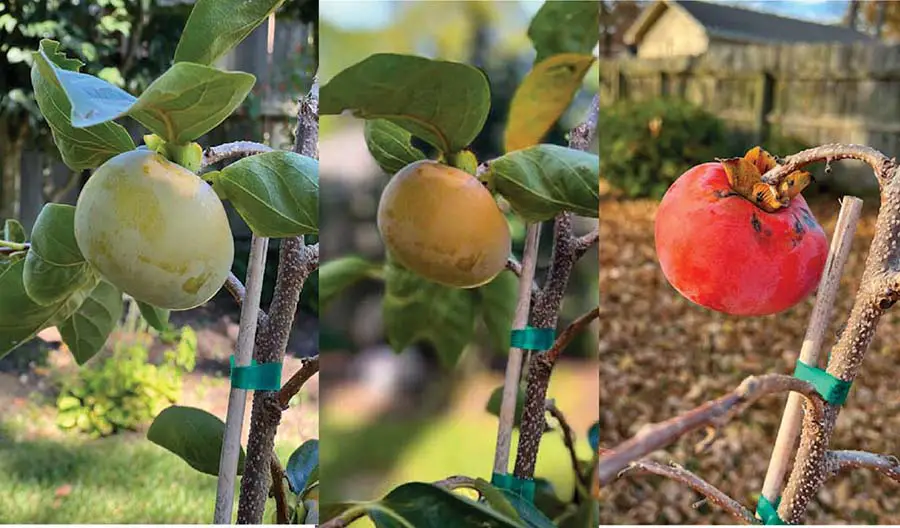
If you grew up near wild persimmon trees, chances are you’ve accidentally bitten into a bitter, dry-tasting, under-ripe persimmon. It’s an unforgettable experience…and one you probably don’t want to repeat.
But the taste of a ripe persimmon is incomparable – unbelievably sweet, complex, ranging from crisp like an apple to soft and pudding-like, depending on the variety. There’s a reason these fruits have been cultivated in China for thousands of years and were highly valued by the Native Americans. In fact, the English word “persimmon” comes from the Algonquin word for the fruit.
The key to unlocking a persimmon’s flavor is to harvest – and eat – the fruit at the perfect time. So how do you know when to pick a persimmon?
Persimmons are ready for harvest in the fall, typically between late August and December depending on variety and climate. Pick astringent varieties when they are deep orange, somewhat translucent, and very soft. Harvest non-astringent persimmons when firm and at mature size and color.
It’s no wonder there’s controversy around the merits of persimmons. But to truly enjoy growing this fruit, you first need to understand when to pick them and how to know they’re at peak ripeness. Read on to learn more about how to perfectly time your persimmon harvest, no matter what kind you grow.
What kind of persimmon tree do you have?
Astringent or Non-Astringent
The first thing to know about harvesting persimmons is that the timing of harvest largely depends on whether your persimmon tree is astringent or non-astringent. The two types vary widely in flavor, texture, and especially when they’re ready for picking. Read my article, Astringent vs. Non-Astringent Persimmons: What’s the Difference?, to find out more about growing (and eating!) these two types.
Non-astringent persimmons stay firm when they’re ripe. Depending on the variety, they can range from bright yellow to deep red-orange, but they are always green when unripe. Plan to harvest when they reach full size and have no trace of green tint left on the skin.
When you pick non-astringent persimmons they should be very firm, like an apple, to slightly soft when pressed, like a just-ripe peach. Either way – firm and crisp, or tender and juicy – the persimmon will be very sweet and ready to eat.
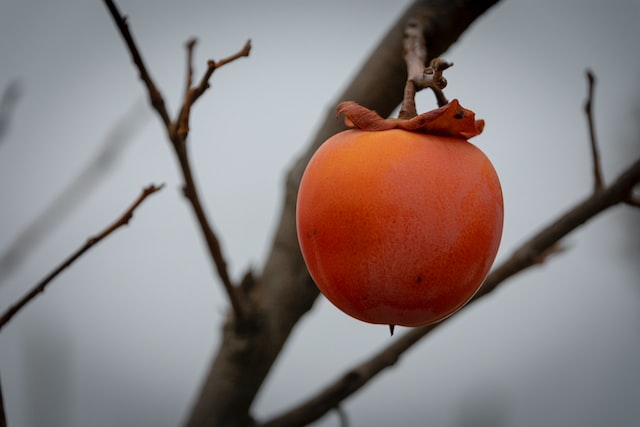
You can tell when an astringent persimmon is ready to pick by its texture and color. Harvest when the persimmons are somewhat soft and give a little when pressed, but are not yet too mushy. The color should be strong, yellow-orange to dark orange-red (depending on the variety) and relatively unblemished.
Astringent persimmons are actually fully ripe when completely soft and gelatinous. But, if you leave them on the tree until that point, one of two things is likely to happen. Either they’ll fall off the tree onto the ground (hello, bugs), or they’ll be eaten by birds, deer, and other critters before you get there. You can collect ripe persimmons from the ground if you check frequently, but you run the risk of the fruits being damaged by the fall from the tree (or by insects).
What’s the answer to this dilemma? Pick astringent persimmons a bit early, when they are soft but still have some firmness. The color of the fruit should be fully developed, but they will continue to soften and sweeten once picked.
Important – don’t eat them yet! Even a slightly under-ripe astringent persimmon will be mouth-puckeringly bitter and dry, thanks to the tannins still present in the fruit. It’s worth waiting for the maple-syrup sweetness and pudding-like texture of a perfectly ripe astringent persimmon.
American or Asian
Besides astringency, the other way persimmons are classified is by species. The two most common are the native American persimmon (Diospyros virginiana) and the Asian (or Oriental/Japanese) persimmon (Diospyros kaki).
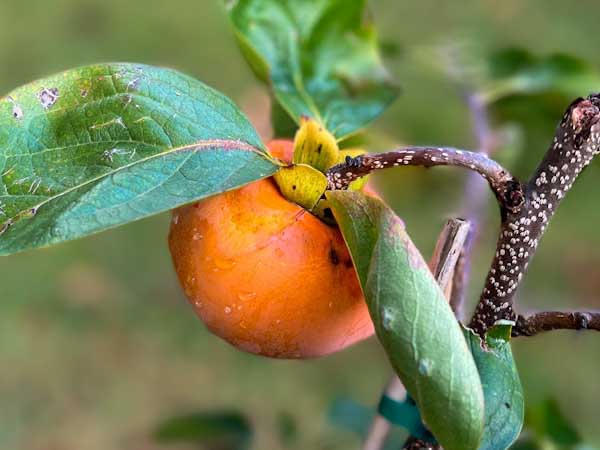
American persimmons are almost all astringent types. They tend to be smaller than Asian varieties, about the size of a plum. American persimmons generally begin ripening early in the fall, around late August to September, but the fruits often ripen at very different times. You might harvest persimmons from the same tree from September all the way to March.
Asian persimmons can be either astringent or non-astringent. In general they are much larger than their American counterparts, closer to the size of a slicing tomato or an apple. With Asian cultivars, whether astringent or non-astringent, allowing them to reach full size and color before harvesting is key.
Read more about these two types in American vs. Asian Persimmons: What’s the Difference?
Will persimmons keep ripening off the tree?
Persimmons continue to ripen and soften once harvested, when left at room temperature. Ripening can be sped up by placing unripe persimmons in a paper bag with ethylene-releasing fruits, such as apples, bananas, or avocados.
Once picked, you can tell astringent persimmons are ripe when completely soft and mushy, almost to the point of falling apart. There is a fine window of opportunity when the persimmon is gooey-soft, but not yet rotten. A key factor is smell – if the persimmon smells sweet, aromatic (floral or honeyed), and appealing, then it’s perfect. If it smells sour or slightly ferment-y, then best to avoid it.
A perfectly ripe astringent persimmon will be so soft that you can (and should!) just eat it with a spoon. The ripening process takes away all remaining astringency from the flesh A fun way to eat ripe astringent varieties like ‘Hachiya’ is to freeze them whole once completely soft, then slice off the top and dig in. The frozen texture of the gooey flesh is just like sorbet, only simpler to make!
Non-astringent persimmons will also continue to soften as they sit out, but they’ll still be fairly firm. The cultivar ‘Fuyu’, in particular, will keep its texture for a long time, and can be kept for months in a cool, dark, dry location.
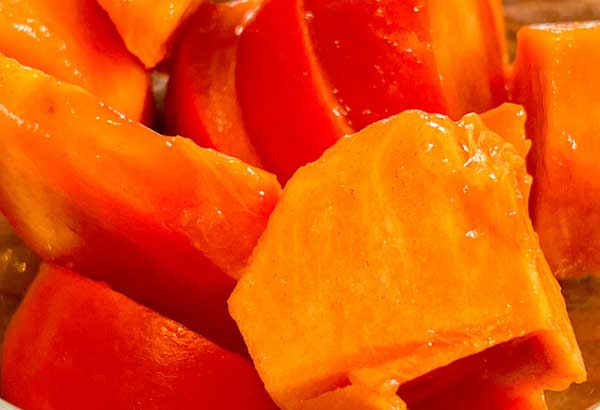
I personally love the crisp, sweet texture of non-astringent persimmons just off the tree. But my favorite thing is to let them soften on the counter just a bit – they become juicy and succulent, like a ripe peach (shown in the picture above).
When to Pick Different Varieties of Persimmons
I’ve included a chart below of harvesting information for many types of persimmons, including mature size, color, texture, and approximate harvest months. These are estimates of ripening times – use this chart as a starting point when determining ripeness or when planning your backyard orchard.
| Variety | Astringent/Non | Size | Shape | Color | Texture | Harvest Time | Zone |
|---|---|---|---|---|---|---|---|
| AMERICAN (D. virginiana): | |||||||
| ‘John Rick’ | astringent | 1.5″2″ | round | orange | very soft | August-Sept. | 4-9 |
| ‘Early Golden’ | astringent | 1.5″-2″ | round | deep orange | very soft | August-Sept. | 4-9 |
| ‘Prok’ | astringent | 1.5″-2″ | round | orange | soft | Sept.-Oct. | 5-8 |
| ‘Yates’ | astringent | 2.5″ | round | orange | soft | August-Sept | 5-9 |
| ASIAN (D. kaki) | |||||||
| ‘Eureka’ | astringent | medium | round, flattened | bright orange | soft | Oct.-Dec. | 8-10 |
| ‘Fuyu’ | non-astringent | large | round, flattened | deep orange | firm | Nov.-Dec. | 7-11 |
| ‘Hachiya’ | astringent | large | oblong, acorn | dark orange | soft | late Oct.-Nov. | 7-10 |
| ‘Chocolate’ | astringent | small-med. | oblong, conical | red-orange | soft | late Oct.-Nov. | 7-11 |
| ‘Ichikikei Jiro’ | non-astringent | med.-large | slightly oblong | bright orange | firm | Oct.-Nov. | 6-9 |
| ‘Tanenashi’ | astringent | large | oblong, conical | yellow-orange | soft | Sept.-Oct. | 7-9 |
| ‘Rojo Brillante’ | astringent | med.-large | oblong, acorn | red-orange | soft | mid Oct.-Nov. | 6-9 |
| ‘Giombo’ | astringent | large | oblong, acorn | light orange | soft | mid Oct.-Nov. | 7-9 |
| ‘Saijo’ | astringent | small | oblong, conical | orange | soft | late Sept.-Oct. | 6-9 |
| HYBRID (D. virginiana + kaki) | |||||||
| ‘Nikita’s gift’ | astringent | 3″ | slightly flattened | orange-red | soft | late Oct.-Nov. | 5-9 |
| ‘Mikkusu’ (JT-02) | astringent | large | round flattened | bright orange | soft | Sept.-Oct. | 5-9 |
| Texas persimmon (D. texana) | astringent | 1″ | round | purple-black | soft | July-Sept. | 7-9 |
Tips for Harvesting Persimmons
Gardening lore suggests that persimmons only ripen after the first frost of the year. This myth has been debunked, however, because frosts can actually damage unripened persimmons. This idea probably came about because persimmons do tend to ripen in mid-to-late fall, which happens to be around the first frost date for many locations.
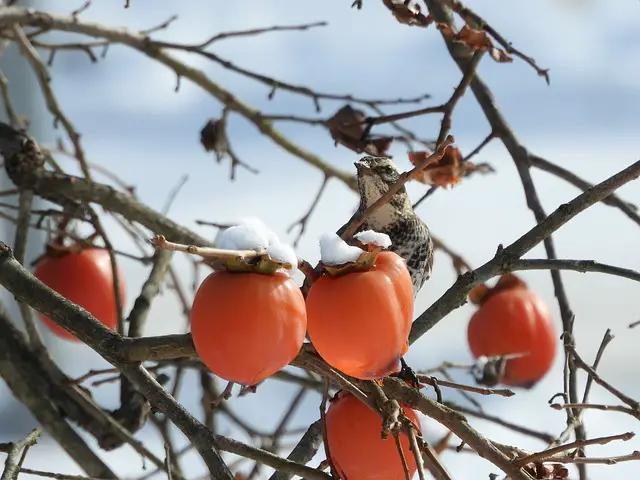
If you’re wondering why some persimmon trees have little to no fruit to harvest, it may simply be because it’s a male tree. Most American persimmon varieties are not self-pollinating, so you need both a male and female tree for pollination, although it’s the females that bear the fruit (read more about this in Persimmon Tree Pollination: Do You Need Two Trees?).
American persimmon trees can grow quite large, (30 to 80 feet) which can make harvesting a challenge. One of the simplest ways is to shake the branches and let the ripe fruit fall to the ground – or if you feel intrepid, climb the tree and shake from up high.
For Asian persimmons, or under-ripe American ones, it’s better to cut them off with pruners rather than pull off by hand. The fruit can be stubbornly attached to the stem, so pulling hard may damage the branch.
Asian persimmon trees typically grow to only 15-30 feet, and can be kept even more compact with regular pruning. (Find out how to do this in my article, Pruning an Asian Persimmon Tree in 5 Simple Steps.) This means that the fruit is easier to reach, and harvesting may only require the use of a small stepladder, if anything.


